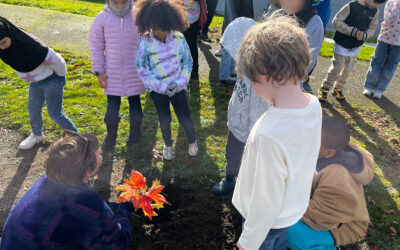![]()
Try these small shifts in teaching practice with big impacts. Each video is about 7-10 minutes long and is designed to be a quick way to get your toes wet with the Ambitious Science Teaching practices. You will recognize familiar practices (such as using vocabulary or doing gallery walks) but the teachers in these videos are taking these practices one-step further. Each video breaks down the practice by describing the talk, task and tools used and provides teacher tips. Be sure to share your variations of these practices on the AST website!
Scaffolds to make students' initial ideas public
An example of how oral prompts and written scaffolds elicit student thinking by eliciting students’ science ideas at the beginning of a unit which helps the teacher makes future instructional decisions in light of the partial understandings, everyday language, and everyday experiences they share.
- 4th/5th Circuits & Pathways
- Science Teaching Practice: Eliciting Students’ Science Ideas
- NGSS: 4-PS3-2 & 4-PS3-4; Science Practices- developing models)
Responsive talk: How students use vocabulary
Eliciting students’ everyday and academic language to understand how they are initially understanding a science phenomenon. Students use particular vocabulary to communicate their ideas. Teacher chooses to respond by using students’ words, instead of introducing science words, at this point in the unit. Interview with teacher debriefing her decisions included.
- 6th
- Force & Motion (acceleration, momentum, inertia)
- Eliciting Students’ Ideas; Academic Language Science talk, Science Vocabulary
- NGSS: MS-PS2-1 & MS-PS2-2
Eliciting students’ everyday and academic language to understand how they are initially understanding a science phenomenon. Students use particular vocabulary to communicate their ideas. Teacher chooses to respond by using students’ words, instead of introducing science words, at this point in the unit. Interview with teacher debriefing her decisions included.
- 6th
- Force & Motion (acceleration, momentum, inertia)
- Eliciting Students’ Ideas; Academic Language Science talk, Science Vocabulary
- NGSS: MS-PS2-1 & MS-PS2-2
Using back-pocket questions to make sense of activities
- 6th
- Force & Motion (acceleration, momentum, inertia)
- Eliciting Students’ Ideas; Academic Language Science talk, Science Vocabulary
- NGSS: MS-PS2-1 & MS-PS2-2
Using a gallery walk to critique student models and explanations
Critiquing models and receiving peer review helps students question their own understanding of science concepts and identify gaps in their own understanding This video shows one way for students to give and receive critiques of their evidence-based scientific explanations. For this gallery walk, students will be critiquing each other’s models of flashlight circuits.
- 4th/5th
- Circuits & Pathways
- Developing and Critiquing Models; Revising Student’s initial ideas
Everyday language and science language
Comparing how students use and have heard science terms in their everyday lives with how we use them in science This video shows an example from a 6th grade physics classroom where students are asked to compare how they’ve heard the words speed, velocity, and acceleration used in their everyday lives with how they use them in science.
- 6th
- Force & Motion (acceleration, momentum, inertia)
- Academic Language
- Science talk, Science Vocabulary
- NGSS MS-PS2-1 & MS-PS2-2
Comparing students' science ideas: scaffolding debate
When teaching in a way that is responsive to student ideas, it is unsurprising that students will disagree. Engaging students in productive talk about their disagreement allows students to broaden their understanding about a key science idea. This video provides an example of one way for teachers to engage students in talk that will compare and contrast their opposing hypotheses.
- 4th/5th
- Circuits & Pathways
- Science Teaching Practice: Constructing evidence-based explanations
- NGSS: Science Practice – Debate/Argumentation using evidence
Creating a "Gotta Have" checklist
This video shows how students generate items for the “gotta have” checklist using participation structures such as pair-share along with writing in science notebooks. Students will use items on this checklist to help them write their explanation. This activity can serve as a prewriting activity for writing a scientific explanation
- 4th/5th
- Circuits & Pathways
- Science Teaching Practice: Constructing Evidence-based explanation
- NGSS: Science Practice – Constructing Evidence-based explanation
Using models to develop a scientific explanation: A sound unit overview
Developing and revising models during a science unit helps students recognize how their thinking has changed overtime in light of evidence from classroom activities. This video shows an overview of a 3rd grade Sound Unit from Day 1 where students develop their initial models about a phenomenon (“Why can a singer shatter a glass with his voice?”), to a mid-point where students revise their model using more detail, and finally how they work in groups to construct a full explanation of the phenomenon using sentence starters to scaffold writing claims with evidence.




 This site is primarily funded by the National Science Foundation (NSF) through Award #1907471 and #1315995
This site is primarily funded by the National Science Foundation (NSF) through Award #1907471 and #1315995